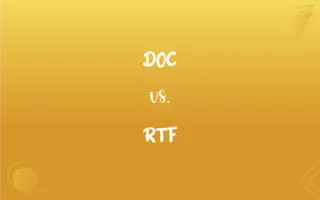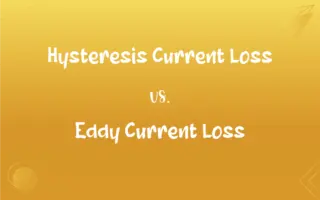Sucrose Centrifugation vs. Cesium Chloride Centrifugation: What's the Difference?
Edited by Aimie Carlson || By Janet White || Published on October 16, 2024
Sucrose centrifugation separates biomolecules via density gradients, while cesium chloride centrifugation uses isopycnic conditions for ultra-high-resolution separation.

Key Differences
Sucrose centrifugation is used to separate biomolecules based on size and density using a gradient of sucrose. Cesium chloride centrifugation separates molecules based on buoyant density in an isopycnic gradient, ideal for DNA purification.
In sucrose centrifugation, a gradient is formed by layering different concentrations of sucrose. Cesium chloride centrifugation involves a self-forming gradient where cesium chloride equilibrates under centrifugal force.
Sucrose centrifugation provides moderate resolution suitable for cell organelles. Cesium chloride centrifugation offers higher resolution, separating molecules with very close densities, like DNA with slight base pair differences.
Sucrose centrifugation is commonly used for fractionating cell components and large biomolecules. Cesium chloride centrifugation is primarily used for DNA and RNA purification, including plasmid DNA isolation.
Sucrose centrifugation operates at lower speeds and shorter durations. Cesium chloride centrifugation requires ultracentrifugation at high speeds for extended periods, often overnight.
ADVERTISEMENT
Comparison Chart
Principle
Separation by size and density gradient
Isopycnic separation by buoyant density
Gradient Formation
Manual layering of sucrose solutions
Self-forming under centrifugal force
Resolution
Moderate, suitable for organelles
High, ideal for DNA/RNA
Typical Applications
Fractionating cell components
Purifying DNA and RNA
Operational Conditions
Lower speed, shorter duration
Ultracentrifugation, often overnight
ADVERTISEMENT
Sucrose Centrifugation and Cesium Chloride Centrifugation Definitions
Sucrose Centrifugation
It provides a gentle medium, preserving the integrity of delicate biological structures.
Sucrose centrifugation enabled the isolation of intact lysosomes.
Cesium Chloride Centrifugation
It requires extended ultracentrifugation, often running overnight for optimal separation.
The DNA sample was subjected to overnight cesium chloride centrifugation.
Sucrose Centrifugation
This method utilizes layered sucrose solutions of varying concentrations for separation.
A gradient of 10-40% sucrose was prepared for the centrifugation process.
Cesium Chloride Centrifugation
It employs a self-generating density gradient under ultracentrifugal forces.
The cesium chloride gradient formed efficiently during the ultracentrifugation process.
Sucrose Centrifugation
Sucrose centrifugation is commonly used in biochemistry and molecular biology labs.
The lab performed sucrose centrifugation to study the subcellular localization of a protein.
Cesium Chloride Centrifugation
Cesium chloride centrifugation is a cornerstone method in molecular genetics.
Researchers used this method to isolate high-quality plasmid DNA.
Sucrose Centrifugation
It is a technique for fractionating cellular components based on their size and density.
Sucrose centrifugation was key in separating mitochondria from a cell lysate.
Cesium Chloride Centrifugation
This technique is highly precise, ideal for separating closely related biomolecules.
Cesium chloride centrifugation separated viral RNA from other nucleic acids.
Sucrose Centrifugation
Sucrose centrifugation involves separating biomolecules using a sucrose density gradient.
Researchers used sucrose centrifugation to isolate chloroplasts from plant cells.
Cesium Chloride Centrifugation
Cesium chloride centrifugation separates molecules based on buoyant density.
DNA was purified using cesium chloride centrifugation for sequencing.
FAQs
Can sucrose centrifugation separate DNA?
It's less effective for DNA; it's more suited for larger structures like organelles.
How do sucrose and cesium chloride gradients differ?
Sucrose gradients are manually prepared, while cesium chloride gradients form automatically.
What are the speed requirements for both methods?
Sucrose centrifugation uses lower speeds; cesium chloride requires ultracentrifugation.
Are these methods compatible with all biomolecules?
They vary; sucrose is gentler but less precise, cesium chloride is more precise but harsher.
Which technique offers higher resolution?
Cesium chloride centrifugation provides higher resolution.
What is sucrose centrifugation used for?
It's used for separating cell components and macromolecules based on size and density.
What is cesium chloride centrifugation primarily used for?
It's used mainly for purifying DNA and RNA.
Is cesium chloride centrifugation suitable for organelle separation?
It's not commonly used for organelles due to its high-resolution focus on smaller molecules.
Can these techniques be used in tandem?
Yes, they can be complementary in complex purification protocols.
Are these methods scalable for industrial use?
Sucrose centrifugation is more scalable; cesium chloride is more specialized.
Can sucrose centrifugation be used for RNA purification?
It's less common due to its lower resolution compared to cesium chloride.
How long do these centrifugation processes take?
Sucrose centrifugation is shorter, while cesium chloride often runs overnight.
How do density gradients affect separation?
They enable separation based on molecule size and buoyant density.
What is a key benefit of cesium chloride centrifugation?
Its ability to precisely separate molecules with minor density differences.
What are the cost implications of each method?
Sucrose centrifugation is generally more cost-effective; cesium chloride requires more expensive equipment and materials.
Is special equipment needed for cesium chloride centrifugation?
Yes, an ultracentrifuge is essential for this method.
How does sample volume affect each method?
Sucrose can handle larger volumes; cesium chloride is better for smaller, concentrated samples.
What safety precautions are needed for cesium chloride centrifugation?
Cesium chloride is toxic; proper handling and disposal are critical.
How does temperature affect these centrifugation methods?
Both require temperature control for optimal separation and molecule integrity.
What is the main advantage of sucrose centrifugation?
It's gentler on biological samples, preserving structure and function.
About Author
Written by
Janet WhiteJanet White has been an esteemed writer and blogger for Difference Wiki. Holding a Master's degree in Science and Medical Journalism from the prestigious Boston University, she has consistently demonstrated her expertise and passion for her field. When she's not immersed in her work, Janet relishes her time exercising, delving into a good book, and cherishing moments with friends and family.
Edited by
Aimie CarlsonAimie Carlson, holding a master's degree in English literature, is a fervent English language enthusiast. She lends her writing talents to Difference Wiki, a prominent website that specializes in comparisons, offering readers insightful analyses that both captivate and inform.






































































